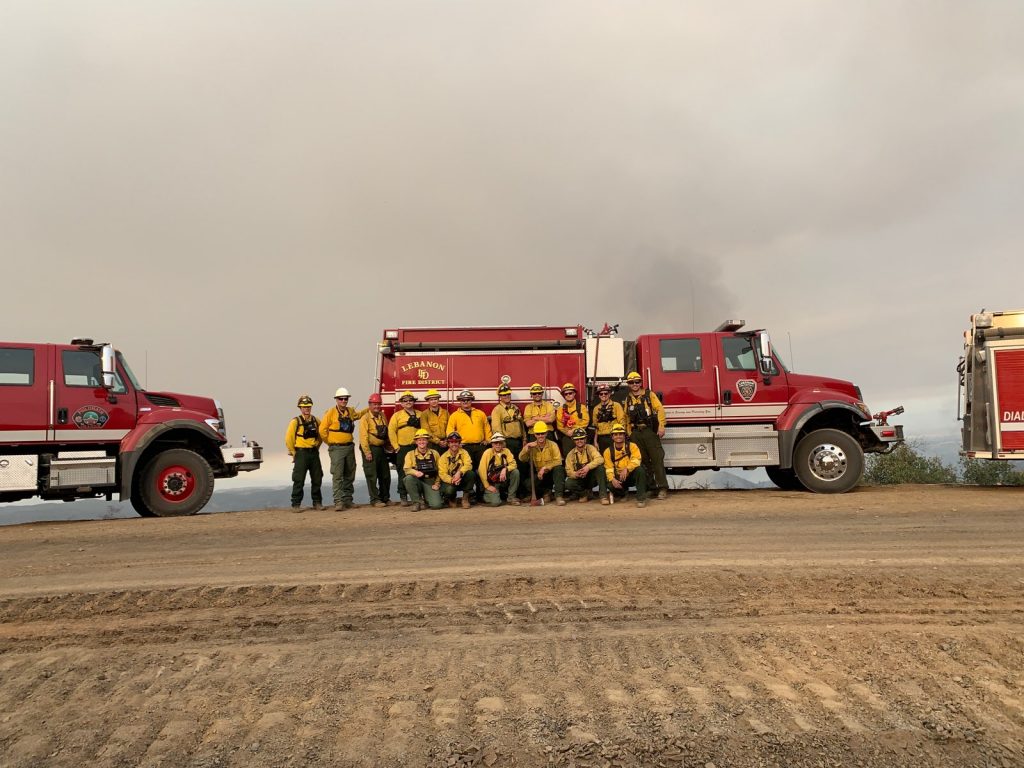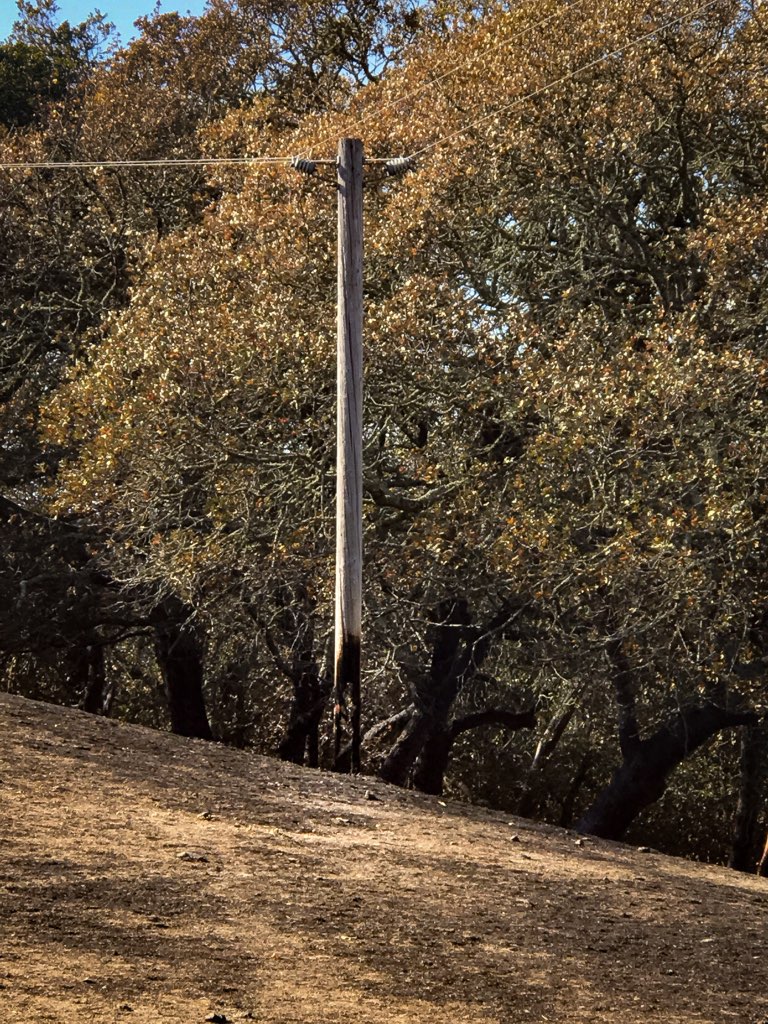Corvallis Firefighters Talk Climate Change
Local Departments Answer California’s Call

In Australia, over 24 million acres have recently burned, taking with them around 3,000 homes, 29 human lives, and over 1 billion killed or displaced animals. Experts have cited long periods of drought and higher overall temperatures as the cause of the longer fire seasons and exacerbated, dry conditions in Australia. While no firefighters from Corvallis have been deployed to the fires, a total of 15 from Oregon were sent to the country. Meanwhile, climate action protests are taking place across the country.
Closer to home, California’s Kincade fire began on the night of October 23, 2019 and spread quickly, as high winds whipped in the mountains surrounding wine country. Beginning near Geyserville, Calif., the fire ultimately engulfed 77,758 acres before being fully contained on November 6. This proved to be the largest fire in Sonoma County history, destroying over 100 homes and buildings, and forcing the evacuation of nearly 200,000 people, with evacuation warnings sent to almost the entire county. Extreme wind events made the fire unpredictable and dangerous, hitting gusts of up to 96 miles per hour.
The Corvallis Fire Department stepped up to help.
Support for Sonoma
“We have their back, and we know they’ll have ours,” Battalion Chief Kevin Fulsher remarked, complementing the Oregon State Fire Marshal’s proactive decision to make agreements with surrounding states in times of need. In the case of the Kincade fire, the state of Oregon sent a total of 75 trucks to help California battle the blaze, including 15 strike teams from Corvallis.
Just after one of the extreme wind events, Battalion Chief Fulsher and his crew departed on a 12 hour journey south to Sonoma County. The 550 mile trip usually takes about 8.5 hours — that is, when you aren’t driving fire trucks that top out at around 60 mph. Sonoma County isn’t the furthest the CFD has journeyed; two years ago they travelled within 40 miles of the Mexican border near San Diego. This most recent trip does, however, signal a new and frightening trend: this is the third year in a row that Corvallis has been called on to send trucks to California.
“Three years ago was the first time we went to California in as long as I have been a part of the CFD,” said Corvallis firefighter Shane Grant.
According to Battalion Chief Fulsher, “They don’t call it a ‘fire season’ in California anymore. They call it a ‘fire year.’”
The conditions in California were some of the driest that his crew had ever seen. Upon arrival, they were shown a sample of a branch taken from the surrounding area that had been measured for live fuel moisture – a statistic that determines how dry the vegetation is, and therefore how likely it is to be consumed by a fire or add fuel to that fire.
“It was critically low,” said Fulsher.
In such dry conditions, fires spread quickly and erratically, as embers are lifted by the wind, causing spot fires. The historic wind event that coincided with the Kincade fire prompted Pacific Gas and Electric (PG&E), the Bay Area’s power company, to shut off power to over 2.8 million customers to avoid active downed power lines.
These power shut-offs cause millions of dollars in loss of revenue for all businesses affected, as well as loss of perishable food due to lack of refrigeration. They are dangerous to people with medical equipment that require power. They are not all encompassing, and therefore not entirely effective; in fact, the Kincade fire is suspected to have started due to a malfunctioning high-voltage transmission line, despite shut-offs.
“Power shut-offs are brutal, but look at this.” Fulsher leaned in to display a picture of a charred telephone pole, saying if that power hadn’t been shut off, and the pole burned through, it would have started yet another fire.
So, what is the best way to combat fires in an increasingly dry, hot environment? The answer is not clear, as there is much debate about which practices are best — even firefighters disagree.
Engineer Josh Crawford said he understands that different firefighters’ experiences and backgrounds lead to different presuppositions about fire prevention. He partially attributes the difficulty in compromising and finding a solution to the fact that we have waited so long without doing much at all as far as prevention. Now, there is a lot at stake, and every option is rather drastic and is bound to upset someone.
Perspectives on Prevention
Currently, the most common methods of fire prevention are prescribed burns and mechanized brush cutters.
Prescribed burns are an age-old indigenous practice used in the Corvallis area. The Kalapuya and surrounding tribes would intentionally burn back brush areas, or areas of dense forest, to promote a healthy Oak Savannah environment, which is more natural and beneficial for native plant and animal species. Prescribed burns are still a fairly common practice, especially in Eastern Oregon.
In Corvallis, the Fire Department is currently working with Herbert Farm and Natural Area to complete prescribed burns and return the area back to natural Oak Savannah – grasslands where the oaks are the dominate trees. As with all fires, this practice causes a lot of smoke. Then there is always the inherent risk that the fire could spread or get out of hand, and cause just as much damage as a wildfire. For example, in 2012, the Colorado State Forest Service started a prescribed fire that escaped and burned over 1400 acres, killing three people and destroying 23 homes.
Firefighter Grant, who grew up on a ranch near Corvallis, said that he understands ranchers being wary of prescribed burns, and not wanting to lose crops if they get out of hand.
Another current prevention method is the use of mechanized brush cutters armed with large blades to help eliminate the density of fuel, and thus limit the intensity of fires. Crawford said that many believe this to be the best practice. Even still, the machinery is very expensive and dangerous.
Climate Change & Risks in Oregon
“Climate change is definitely an issue,” said Engineer Crawford.

Recent studies offer empirical evidence to back up this claim. A study from July of 2019 by the American Geophysical Union showed that as conditions became drier and the overall temperature rose, the amount of land burned by wildfires in California has increased fivefold since 1972. NASA scientists reported that the 2010s were the hottest decade ever measured on Earth, with 2019 ranking as the second hottest year ever measured.
Fires in California are happening with increasing frequency and voracity, destroying homes and structures, and displacing hundreds of thousands of people and animals. Nine of the ten most destructive fires in the history of the state happened since 2003.
While Oregon is known for being wet, the fact remains that we are at risk of fire as well.
“We have a lot of fuel,” said Fulsher. “Consider the Tillamook fire.”
One of the largest, most catastrophic fires in Oregon history, the Tillamook Burn began in 1933 and continued in intervals through 1951, destroying over 500 square miles. These fires occurred in one of the state’s wettest regions on the Coastal Range.
With continued uncertainty due to our changing climate, the best thing citizens of Corvallis can do is be prepared. “Although the amount of time fires like this happen around us is low, when it does happen, it will be severe,” Fulsher warned.
Personal Preparedness & Fire Safety
Fulsher, Crawford, and Grant all agreed that one of the best ways to prevent a fire is personal house preparedness.
“Active mitigation is important,” said Crawford. “Creating green spaces around houses, keeping your gutters clean, and making sure dry leaves aren’t piled up around your home.”
Fulsher added that fire-smart landscaping is one of the better things you can do to be prepared. “Landscape with the thought that whatever you put around your house will dictate whether or not your house catches on fire.”
He explained that while many people prefer bark chips or mulch around their home, the smarter option would be rocks or gravel. Oregon Department of Forestry has also created an extensive list of tips and ideas for staying fire-safe, which can be accessed on their website.
Crawford added that continued education for older children is very important, and often overlooked. “We get fire safety education when we are young, but then we don’t follow up on it, and I’m not sure it really sticks.”
The Eagle Creek fire in the Columbia River Gorge in 2017 and the Timberhill fire in Corvallis in 2014 were both started by young adults.
According to some of the Corvallis firefighters who battled the Kincade blaze, the best thing you can do when a fire occurs is to stay out of the way and evacuate when asked.
“Moving fire apparatus is already dangerous as is; having to navigate the streets with civilians trying to get a better look at the fire is a hazard that doesn’t need to be there,” commented Fulsher. Plus, if something were to happen to a bystander, that immediately shifts the firefighter’s focus from doing their job to jumping into immediate EMT mode.
One thing everyone can do is thank our local firefighters. We can show them we appreciate that they keep us safe by dropping some goodies off at the local Fire Department’s main office at 400 NW Harrison Boulevard, or by simply shaking their hands and saying thank you.
Special thanks to Battalion Chief Kevin Fulsher, Engineer Josh Crawford, and firefighter Shane Grant for taking the time to be interviewed, and thanks to all the firefighters that helped battle the Kincade fire.
For more information on how to make your house fire safe, how to be fire-ready, and ideas about landscaping to make a green space around your home, see Oregon Department of Forestry’s website: https://www.oregon.gov/odf/
The Corvallis Fire Department does not expect to send any firemen to Australia at this time, but stay updated with our daily online articles for current news.
Do you have a story for The Advocate? Email editor@corvallisadvocate.com


